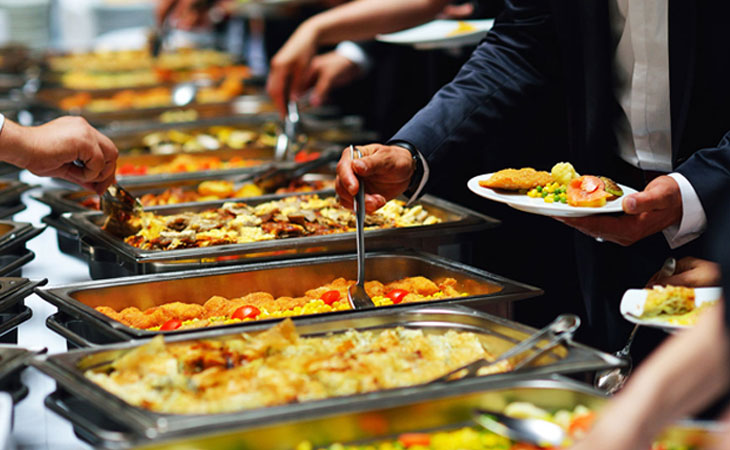FOOD
The Essential Guide to Corporate Catering Services: Enhancing Workplace Events with Culinary Excellence

Corporate catering services have become an indispensable part of the business world, offering solutions that range from everyday office lunches to large-scale corporate events.
Catering plays a crucial role in creating a positive and productive environment, making meetings, conferences, and celebrations more enjoyable and memorable.
This comprehensive guide explores the various aspects of corporate catering services, their benefits, and tips for choosing the right provider for your needs.
Understanding Corporate Catering Services
Corporate catering services provide food and beverages for business-related functions. These services can cater to various events, including:
- Office Meetings: From simple coffee breaks to elaborate lunches, catering services ensure that participants stay focused and energized.
- Training Sessions: Well-planned meals can keep trainees motivated and attentive throughout the sessions.
- Corporate Events: Gala dinners, product launches, and holiday parties are made more impressive with professionally catered food.
- Conferences and Seminars: High-quality catering can enhance the experience for attendees, reflecting positively on the host organization.
Types of Corporate Catering Services
- Drop-Off Catering: This service involves delivering pre-prepared meals to the office or event location. It’s ideal for informal meetings or when there are no facilities for on-site food preparation.
- Full-Service Catering: This comprehensive service includes food preparation, delivery, setup, service, and cleanup. It’s suitable for larger events that require professional presentation and service staff.
- Buffet Style: Offers a variety of food options laid out for self-service. This style is flexible and allows guests to choose according to their preferences.
- Plated Service: A more formal option where guests are served individually plated meals at their tables. This is often used for high-end corporate events.
- Food Stations: Multiple stations are set up, each offering different types of food. This interactive approach can include live cooking stations, adding an element of entertainment.
- Boxed Lunches: Individually packaged meals that are convenient for training sessions, picnics, or on-the-go meetings.
Benefits of Corporate Catering Services
Enhances Employee Morale and Productivity
Providing quality meals at the workplace shows that the company values its employees, which can boost morale and productivity. Well-fed employees are more likely to stay focused and energized throughout the day.
Saves Time and Increases Efficiency
Organizing food for a large group can be time-consuming. Catering services handle all the details, allowing employees to focus on their work. This efficiency is especially valuable during busy periods or important projects.
Professionalism and Presentation
Catering services provide a level of professionalism that reflects positively on the company. High-quality food and presentation can impress clients, partners, and employees, enhancing the company’s reputation.
Customizable Options
Catering services offer a range of menus and customization options to suit different dietary needs and preferences. This flexibility ensures that everyone is satisfied, regardless of their dietary restrictions.
Convenience
Catering services take care of all aspects of meal preparation, delivery, setup, and cleanup. This convenience allows organizers to focus on the event itself rather than worrying about the logistics of food service.
Planning a Corporate Catering Event
Effective planning is key to a successful corporate catering event. Here are some steps to ensure your event goes smoothly:
1. Define Your Goals and Budget
Start by determining the purpose of the event and your budget. Understanding your goals will help you choose the right catering service and menu options. Consider the number of attendees, the type of event, and any special requirements.
2. Choose the Right Catering Service
Select a catering service that specializes in corporate events and has a good reputation. Look for reviews, ask for recommendations, and consider doing a tasting session before making a decision. Ensure that the caterer can handle the size and scope of your event.
3. Plan the Menu
Work with the caterer to design a menu that suits the event and accommodates dietary restrictions. Consider offering a variety of options, including vegetarian, vegan, gluten-free, and other special diets. Balance your menu with a mix of proteins, vegetables, and grains to cater to diverse tastes.
4. Logistics and Setup
Coordinate with the catering service to ensure smooth delivery and setup. Consider the layout of the venue, the number of serving stations, and the flow of guests. Ensure that there are enough tables, chairs, and utensils for everyone.
5. Timing
Plan the timing of food service to align with the event schedule. For example, serve light refreshments during breaks, a full meal during lunch, and dessert or coffee during closing sessions. Ensure that the food is served fresh and at the appropriate temperature.
6. Additional Services
Consider whether you need additional services such as bartenders, waitstaff, or on-site chefs. These services can enhance the experience and ensure that everything runs smoothly.
7. Feedback and Evaluation
After the event, gather feedback from attendees about the catering service. This feedback will help you make improvements for future events and ensure that your catering meets the expectations of your guests.
Popular Corporate Catering Menu Options
A successful corporate catering menu balances variety, flavor, and dietary inclusivity. Here are some popular options for different types of meals:
Breakfast
- Continental Breakfast: Assorted pastries, muffins, bagels, fresh fruit, yogurt, and coffee.
- Hot Breakfast: Scrambled eggs, bacon, sausage, hash browns, pancakes, and toast.
- Healthy Options: Smoothie bowls, granola, fresh fruit, and egg white omelets.
Lunch
- Sandwich Platters: Assorted sandwiches and wraps, including vegetarian options, served with sides like chips, salads, and pickles.
- Salad Bar: A variety of greens, toppings, proteins, and dressings, allowing guests to customize their salads.
- Hot Entrées: Options like grilled chicken, pasta dishes, stir-fries, and roasted vegetables.
Snacks and Refreshments
- Finger Foods: Cheese and cracker platters, vegetable crudités, hummus, and dips.
- Beverages: Coffee, tea, soda, bottled water, and juice.
Dinner
- Buffet Style: An array of hot dishes, including meat, fish, vegetarian options, sides, and desserts.
- Plated Meals: A more formal option with starters, main courses, and desserts served to each guest.
Desserts
- Mini Desserts: Bite-sized treats like brownies, cookies, and pastries.
- Fruit Platters: Fresh seasonal fruits for a lighter, healthier option.
Special Dietary Needs
- Vegetarian/Vegan: Plant-based proteins, tofu dishes, salads, and vegetable-based soups.
- Gluten-Free: Gluten-free bread, pasta, and dessert options.
- Allergen-Free: Dishes free from common allergens like nuts, dairy, and shellfish.
Trends in Corporate Catering
Corporate catering is continually evolving, with new trends emerging to meet the changing tastes and needs of businesses. Here are some current trends in corporate catering:
Health and Wellness
There is a growing demand for healthier catering options, including organic, low-calorie, and nutrient-dense foods. Caterers are offering more plant-based and whole food options to meet this demand.
Sustainability
Eco-friendly catering is becoming more popular, with a focus on locally sourced ingredients, sustainable seafood, and biodegradable packaging. Reducing food waste and supporting local farmers are key aspects of this trend.
Interactive Food Stations
Interactive food stations, such as build-your-own taco bars or salad stations, allow guests to customize their meals. This trend adds an element of fun and engagement to the dining experience.
Ethnic and Global Cuisine
Incorporating diverse cuisines into catering menus is a popular trend. Offering dishes from different cultures, such as Mediterranean, Asian, or Latin American cuisine, can add excitement and variety to the menu.
Technology Integration
The use of technology in catering, such as online ordering systems and mobile apps, is streamlining the catering process. This trend makes it easier to customize orders, track deliveries, and manage events.
Conclusion
Corporate catering services play a vital role in enhancing workplace events, offering convenience, professionalism, and a wide range of menu options to suit any occasion. By carefully planning and selecting the right catering service, businesses can create memorable and enjoyable experiences for their employees, clients, and partners. Whether it’s a casual office lunch or a formal gala dinner, a well-executed catering service can leave a lasting impression and contribute to the success of the event. Embrace the culinary excellence of corporate catering and make your next workplace event a gastronomic success.
Stay ahead of the curve with the freshest news updates by exploring TodayFirstMagazine!







